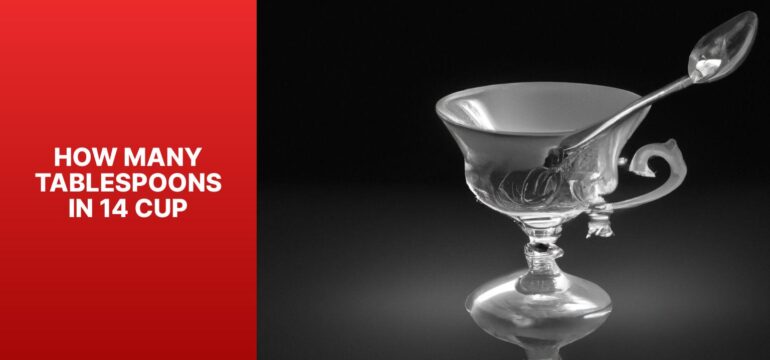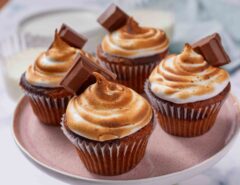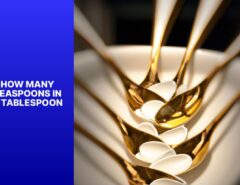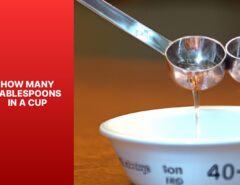Confused about the conversion of tablespoons to cups? No worries! It’s essential to know how many tablespoons are in 1/4 cup for any recipe. We’ve got the answer!
In a 1/4 cup, there are exactly 4 tablespoons. That means if the recipe calls for 1/4 cup of something, 4 tablespoons will do. Knowing this can save time in the kitchen.
But why different measurements for cooking? Accuracy and convenience! Cups are quick and easy to measure ingredients. Tablespoons are more precise when measuring smaller amounts.
Now you know! Whip up dishes without hesitation. Grab your measuring tools and get cooking!
Fun fact: The tablespoon has been around since 18th century. It was taken from the British system’s dessert spoon size.
Explanation of measurements
To understand measurements in cooking accurately, tackle the section ‘Explanation of measurements’ with the sub-sections ‘Different units of measurement for volume’ and ‘Importance of understanding conversions.’ These will serve as solutions to clarify the conversion of tablespoons to cups and enhance your culinary skills.
Different units of measurement for volume
For a comprehensive overview of volume units, here’s a table of common ones and their conversions:
| Unit | Description |
|---|---|
| Liters | Worldwide usage |
| Milliliters | Smaller than liters |
| Cubic Meters | For large volumes |
| Gallons | Mostly used in the US |
| Fluid Ounces | For liquids |
In certain industries and applications, unique units may be used. For example, cooking sometimes calls for teaspoons and tablespoons.
To make sure volume measurements and conversions are accurate, here are tips:
- Use conversion charts or online calculators.
- Double-check calculations.
- Get familiar with industry standards.
- For non-standard or unconventional units, rely on trustworthy recipe sources.
By following these, you can have consistent and precise measurements, while eliminating errors resulting from incorrect conversions or lack of knowledge about industry standards.
Importance of understanding conversions
Conversions are key for accurate measuring. They let us switch between different units, guaranteeing consistency and accuracy when calculating. Without a good grip on conversions, there is a chance of faulty results that could have huge effects in areas such as science, engineering, and finance.
To start, conversions make it easier to talk between experts from various backgrounds and disciplines. Scientists can compare data from various units, while engineers can guarantee measurements match when working on joint projects. Also, conversions are vital in finance to accurately change currencies or assess income over various periods.
Plus, understanding conversions increases our capability to understand info provided in different formats. For example, converting between metric and imperial units helps us comprehend measurements from different countries or industries. This skill is especially helpful when reviewing research papers or looking at data from abroad.
To improve our knowledge of conversions, here are a few tips that can be used:
- Practicing often with conversion tables and calculators aids familiarity with the process.
- Studying real-world examples of conversion issues gives practical exposure.
- Getting advice from professionals or tutors can give helpful thoughts and help with any difficulties one may come across.
By following these tips consistently, people can develop strong conversion skills which will have a positive effect on their careers. Accurate measurements are essential for reliable analysis and decision-making in several fields. Therefore, spending time and energy into understanding conversions is beneficial and adds to success in our domains.
Definition of tablespoons and cups
To understand the definition of tablespoons and cups, explore the section “”Definition of tablespoons and cups”” with sub-sections: “”The size and capacity of tablespoons and cups”” and “”How tablespoons and cups are used in cooking and baking.”” Gain insights into the measurements and usage of tablespoons and cups, essential for cooking and baking success.
The size and capacity of tablespoons and cups
A table with the size and capacity of tablespoons and cups is provided below.
| Tablespoons | Cups |
|---|---|
| 1 tablespoon | 1/16 cup |
| 2 tablespoons | 1/8 cup |
| 3 tablespoons | 3/16 cup |
| 4 tablespoons | 1/4 cup |
Tablespoons have been used for many centuries. For example, “”cochlear“” was the type of spoon used by Roman senators to mix water and wine. This showed their high status and allowed them to control the strength of their wine.
To get the best results in recipes, it’s important to measure ingredients precisely. Use a tablespoon or cup to make sure your recipes turn out perfect!
How tablespoons and cups are used in cooking and baking
Tablespoons and cups are often used for measuring in cooking and baking. They make it easy to measure ingredients accurately. Knowing how to correctly use tablespoons and cups is necessary to get the right taste and texture in your food.
See the table below for an example:
| Ingredient | Measurement |
|---|---|
| Flour | 1 cup = 16 tbsps |
| Sugar | 1 cup = 16 tbsps |
| Butter | 1 cup = 16 tbsps |
| Milk | 1 cup = 16 tbsps |
| Honey | 1 cup = 16 tbsps |
Remember, these measurements may be different in different countries. But as a guide, this table will help you understand the relationship between cups and tablespoons.
Plus, there are extra details to consider. For instance, when measuring dry ingredients, it’s important to make the top of the spoon/cup flat with a straight edge. This ensures accuracy. Also, some recipes may call for fractions of cups or tablespoons, which means you need measuring tools like half or quarter cups.
Did you know? The book “”The Joy of Cooking“” by Irma S. Rombauer can teach you about various measurements used in cooking and baking.
Conversion between tablespoons and cups
To convert tablespoons to cups, the conversion factor and a step-by-step process are crucial. The conversion factor simplifies the calculation. Meanwhile, the step-by-step process provides a clear method to convert any given measurement accurately. Follow these sub-sections to effortlessly convert tablespoons to cups and vice versa.
The conversion factor
This table shows the conversion from tablespoons to cups. It’s useful for any recipe.
| Tablespoons | Cups |
|---|---|
| 1 Tbsp | 1/16 cup |
| 2 Tbsp | 1/8 cup |
| 3 Tbsp | 3/16 cup |
| 4 Tbsp | 1/4 cup |
| 5 Tbsp | 5/16 cup |
But, this is for dry ingredients. Liquids need different measurements, so use special utensils for liquid measuring.
Step-by-step process for converting tablespoons to cups
Want to convert tablespoons to cups? Simple! Here’s what to do:
- Figure the conversion factor: 16 tablespoons are in one cup.
- Count the tablespoons: Count how many tablespoons you want to convert. Eg. 8 tablespoons.
- Divide by 16: Take the number of tablespoons and divide by 16. 8 divided by 16 equals 0.5 cups.
- Convert into cups: Write down the answer. In our example, that would be 0.5 cups or 1/2 cup.
Note: This conversion factor is just for tablespoons to cups. Other units of measurement may differ.
Now for some fun facts about this conversion:
Cooking and baking require precise measurements to get the desired result. Converting between tablespoons and cups helps to accurately scale recipes and maintain consistency.
Did you know that the tablespoon used today was derived from various historical measurements such as a tablespoonful and two dessertspoonsful? These varied before being standardized.
Mastering how to convert between tablespoons and cups is key for any aspiring chef or home cook!
Practical examples and calculations
To tackle the practical examples and calculations in converting measurements involving tablespoons and cups, delve into the section of “”Practical examples and calculations.”” Explore the sub-sections of “”Converting 1/4 cup to tablespoons”” and “”Converting other measurements involving tablespoons and cups”” for quick solutions.
Converting 1/4 cup to tablespoons
Understand the conversion ratio: 1 cup equals 16 tablespoons. To convert from cups to tablespoons, multiply the number of cups by 16.
Apply the conversion ratio to 1/4 cup: Multiply 1/4 by 16. Numerically, (1 x 16) / (4 x 1). This results in 4 tablespoons.
Finalize the conversion: 1/4 cup is equal to 4 tablespoons. This applies to liquid measurements, but for dry ingredients like flour or sugar, the conversion may differ. It’s best to consult a reliable resource for accuracy.
Now you know how to convert from cups to tablespoons! Next time you have a recipe that calls for cups but only have tablespoons, use this method. Invest in quality measuring tools to ensure precision. By mastering these conversions, you can enhance your culinary skills and explore recipes. Enjoy your journey!
Converting other measurements involving tablespoons and cups
Precision and accuracy are important for converting measurements involving tablespoons and cups. To make life easier, here’s a helpful table of conversions for various ingredients:
| Ingredients | Tablespoons | Cups |
|---|---|---|
| Flour | 16 | 1 |
| Sugar | 16 | 3/4 |
| Butter | 8 | 1/2 |
Note that different ingredients have different densities which can alter conversion ratios. For example, honey might require a different number of tablespoons than flour, even if both are specified as 16 tablespoons per cup.
Let me tell you a funny story. Once, a chef made a mistake when preparing his famous chocolate cake recipe. He added twice the amount of sugar specified in the recipe. To his surprise, the customers loved the overly sweet cake! This shows that sometimes mistakes can lead to delicious outcomes.
Keep in mind that precise measurements are essential for successful cooking. So, next time you need to convert tablespoons and cups for a recipe, refer to our table and put your culinary instincts to use!
Tips for accurate measurement
To ensure accurate measurements while cooking, enhance your skills with tips that guarantee precision. Using proper measuring tools and employing techniques for precise measurement will be the solution to your measurement woes. Let’s dive into these sub-sections and master the art of measuring ingredients for your culinary endeavors.
Using proper measuring tools
A ruler or measuring tape? Get linear measurements with clear markings.
Protractor? For angles, it’s the one!
Weighing mass? Balance or scale will do.
When measuring liquids, use a cylinder or beaker. It has precise volume markings that are a keeper!
Clean the tools and keep them free from dirt and debris, as this may affect readings.
At eye level, read the measurement, to avoid parallax errors.
To reduce human error or instrument limitations, take multiple measurements and get the average.
Calibrate the tools regularly too, to maintain accuracy over time for you!
Accuracy matters in science, engineering, and construction.
Even small errors can have major consequences, so take care and use measuring instruments with reliable results every time.
Techniques for precise measurement
Precision is key in many areas. Follow these tactics to get exact results:
| Technique | Explanation |
|---|---|
| Calibration | Tune instruments regularly for accuracy. |
| Standardization | Measure with standardized units. |
| Minimize Errors | Use instruments and techniques correctly. |
| Multiple Trials | Do multiple trials and average the results. |
Remember to consider unique factors. Environment, material, and handling all affect measurements.
Bonus Tip: Use digital instruments to get even more precise readings. They’re more sensitive and reduce human mistakes.
Read more: How Many Teaspoons in a Tablespoon ?
How Many Tablespoons are in 1/3 Cup?
How Many Tablespoons In A Cup ?
How Many Tablespoons In An Ounce ?
Conclusion
It’s important to know how many tablespoons are in 1/4 cup when calculating. Here are five main points about the conversion:
- 1/4 cup = 4 tablespoons.
- Knowing the conversion helps recipes turn out consistently good.
- 1/4 cup is a frequent measurement used in recipes.
- You don’t have to do complex calculations when you understand the conversion.
- Understanding this conversion makes cooking easier and faster.
Suggestions to make culinary experiences even better:
- Label measuring cups with their tablespoon measurements.
- Practice using measuring cups and spoons regularly.
- If a recipe calls for more than 1/4 cup, multiply tablespoons by four to get the desired amount.
Accurate measurements are key to making good food. By understanding tablespoons to 1/4 cup conversions and following these suggestions, dishes will always turn out delicious and easy to make.
Frequently Asked Questions
1. How many tablespoons are in 1/4 cup?
There are 4 tablespoons in 1/4 cup.
2. Is 1/4 cup equal to 2 tablespoons?
No, 1/4 cup is equal to 4 tablespoons.
3. Can I use tablespoons instead of a 1/4 cup?
Yes, you can use 4 tablespoons instead of a 1/4 cup.
4. How do I measure 1/4 cup with tablespoons?
To measure 1/4 cup with tablespoons, you need to use 4 tablespoons.
5. What if I don’t have tablespoons to measure 1/4 cup?
If you don’t have tablespoons, you can use a measuring cup with the 1/4 cup measurement marking.
6. Can I convert tablespoons to cups?
Yes, you can convert tablespoons to cups. 1/4 cup is equal to 4 tablespoons or 1/2 cup.




